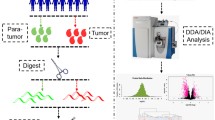Abstract
This study aimed to identify candidate biomarkers associated with stage I non-small cell lung cancer (NSCLC). Sera from three groups, a lung cancer group (n = 11), benign control group (n = 12), and normal control group (n = 10), were collected and pooled. Protein expression profiles were analyzed by a combination of two-dimensional electrophoresis (2DE) and matrix-assisted laser desorption ionization mass spectrometry (MALDI-MS). These methods were used to separate, screen, and identify proteins that were differentially expressed between stage I NSCLC and controls. Differentially expressed proteins were validated by both Western blot and ELISA in an expanded sample size (22, 18, and 18 in three groups, respectively). MALDI-MS identified 12 differentially expressed proteins in the lung cancer group compared to the two control groups. Expression of carbonic anhydrase 1 (CA1) was validated by Western blot. CA1 was significantly elevated in the lung cancer group compared to controls. ELISA results confirmed that CA1 in the lung cancer group (3.18 ± 1.27 ng/mL, n = 22) was highly expressed in stage I NSCLC patients compared to those in the benign control group (2.21 ± 0.71 ng/mL, n = 18) and the normal control group (2.04 ± 0.63 ng/mL, n = 18) (P = 0.001). In conclusion, we provide evidence that CA1 is highly expressed in the sera of stage I NSCLC patients. Additionally, CA1 might serve as a novel biomarker for early detection of NSCLC.



Similar content being viewed by others
References
Jemal A, Bray F, Center MM, Ferlay J, Ward E, Forman D. Global cancer statistics. CA Cancer J Clin. 2011;61(2):69–90. doi:10.3322/caac.20107.
Hoffman PC, Mauer AM, Vokes EE. Lung cancer. Lancet. 2000;355(9202):479–85. doi:10.1016/S0140-6736(00)82038-3.
National Lung Screening Trial Research Team, Aberle DR, Adams AM, Berg CD, Black WC, Clapp JD, et al. Reduced lung-cancer mortality with low-dose computed tomographic screening. N Engl J Med. 2011;365(5):395–409. doi:10.1056/NEJMoa1102873.
Halling KC, Rickman OB, Kipp BR, Harwood AR, Doerr CH, Jett JR. A comparison of cytology and fluorescence in situ hybridization for the detection of lung cancer in bronchoscopic specimens. Chest. 2006;130(3):694–701. doi:10.1378/chest.130.3.694.
Spira A, Beane JE, Shah V, Steiling K, Liu G, Schembri F, et al. Airway epithelial gene expression in the diagnostic evaluation of smokers with suspect lung cancer. Nat Med. 2007;13(3):361–6. doi:10.1038/nm1556.
Patz Jr EF, Campa MJ, Gottlin EB, Kusmartseva I, Guan XR, Herndon 2nd JE. Panel of serum biomarkers for the diagnosis of lung cancer. J Clin Oncol. 2007;25(35):5578–83. doi:10.1200/JCO.2007.13.5392.
Pecot CV, Li M, Zhang XJ, Rajanbabu R, Calitri C, Bungum A, et al. Added value of a serum proteomic signature in the diagnostic evaluation of lung nodules. Cancer Epidemiol Biomarkers Prev. 2012;21(5):786–92. doi:10.1158/1055-9965.EPI-11-0932.
Ritorto MS, Borlak J. Combined serum and tissue proteomic study applied to a c-Myc transgenic mouse model of hepatocellular carcinoma identified novel disease regulated proteins suitable for diagnosis and therapeutic intervention strategies. J Proteome Res. 2011;10(7):3012–30. doi:10.1021/pr101207t.
Zhang W, Miao J, Wang S, Zhang Y. The protective effects of beta-casomorphin-7 against glucose-induced renal oxidative stress in vivo and vitro. PLoS One. 2013;8(5):e63472. doi:10.1371/journal.pone.0063472.
Song QB, Hu WG, Wang P, Yao Y, Zeng HZ. Identification of serum biomarkers for lung cancer using magnetic bead-based SELDI-TOF-MS. Acta Pharmacol Sin. 2011;32(12):1537–42. doi:10.1038/aps.2011.137.
Jeong HC, Kim GI, Cho SH, Lee KH, Ko JJ, Yang JH, et al. Proteomic analysis of human small cell lung cancer tissues: up-regulation of coactosin-like protein-1. J Proteome Res. 2011;10(1):269–76. doi:10.1021/pr100714b.
Dowling P, O’Driscoll L, Meleady P, Henry M, Roy S, Ballot J, et al. 2-D difference gel electrophoresis of the lung squamous cell carcinoma versus normal sera demonstrates consistent alterations in the levels of ten specific proteins. Electrophoresis. 2007;28(23):4302–10. doi:10.1002/elps.200700246.
Albert JM, Gonzalez A, Massion PP, Chen H, Olson SJ, Shyr Y, et al. Cytoplasmic clusterin expression is associated with longer survival in patients with resected non small cell lung cancer. Cancer Epidemiol Biomarkers Prev. 2007;16(9):1845–51. doi:10.1158/1055-9965.EPI-07-0146.
Zhu HF, Li J, Huang L, Yan YQ. Intrahepatic cholangiocarcinoma: a clinicopathologic study of 37 resected cases. Hepatogastroenterology. 2013;60(122):263–7. doi:10.5754/hge12711.
Perez-Sayans M, Garcia-Garcia A, Scozzafava A, Supuran CT. Inhibition of V-ATPase and carbonic anhydrases as interference strategy with tumor acidification processes. Curr Pharm Des. 2012;18(10):1407–13.
Stander BA, Joubert F, Tu C, Sippel KH, McKenna R, Joubert AM. In vitro evaluation of ESE-15-ol, an estradiol analogue with nanomolar antimitotic and carbonic anhydrase inhibitory activity. PLoS One. 2012;7(12):e52205. doi:10.1371/journal.pone.0052205.
Syrjanen L, Luukkaala T, Leppilampi M, Kallioinen M, Pastorekova S, Pastorek J, et al. Expression of cancer-related carbonic anhydrases IX and XII in normal skin and skin neoplasms. APMIS. 2014;122(9):880–9. doi:10.1111/apm.12251.
Aomatsu N, Yashiro M, Kashiwagi S, Kawajiri H, Takashima T, Ohsawa M, et al. Carbonic anhydrase 9 is associated with chemosensitivity and prognosis in breast cancer patients treated with taxane and anthracycline. BMC Cancer. 2014;14:400. doi:10.1186/1471-2407-14-400.
Wykoff CC, Beasley N, Watson PH, Campo L, Chia SK, English R, et al. Expression of the hypoxia-inducible and tumor-associated carbonic anhydrases in ductal carcinoma in situ of the breast. Am J Pathol. 2001;158(3):1011–9. doi:10.1016/S0002-9440(10)64048-5.
Adams A, van Brussel AS, Vermeulen JF, Mali WP, van der Wall E, van Diest PJ, et al. The potential of hypoxia markers as target for breast molecular imaging—a systematic review and meta-analysis of human marker expression. BMC Cancer. 2013;13:538. doi:10.1186/1471-2407-13-538.
Unwin RD, Harnden P, Pappin D, Rahman D, Whelan P, Craven RA, et al. Serological and proteomic evaluation of antibody responses in the identification of tumor antigens in renal cell carcinoma. Proteomics. 2003;3(1):45–55. doi:10.1002/pmic.200390008.
Conflicts of interest
None
Ethical approval
All procedures performed in studies involving human participants were in accordance with the ethical standards of the Ethics Committee of Tianjin Chest Hospital and with the 1964 Helsinki declaration and its later amendments or comparable ethical standards.
Informed consent
Informed consent was obtained from all individual participants included in the study.
Author information
Authors and Affiliations
Corresponding author
Rights and permissions
About this article
Cite this article
Wang, Db., Lu, Xk., Zhang, X. et al. Carbonic anhydrase 1 is a promising biomarker for early detection of non-small cell lung cancer. Tumor Biol. 37, 553–559 (2016). https://doi.org/10.1007/s13277-015-3834-z
Received:
Accepted:
Published:
Issue Date:
DOI: https://doi.org/10.1007/s13277-015-3834-z




